| Postwar Unrest Reading with Questions |
|---|
| www.studenthandouts.com ↣ American History ↣ American History Readings with Questions |
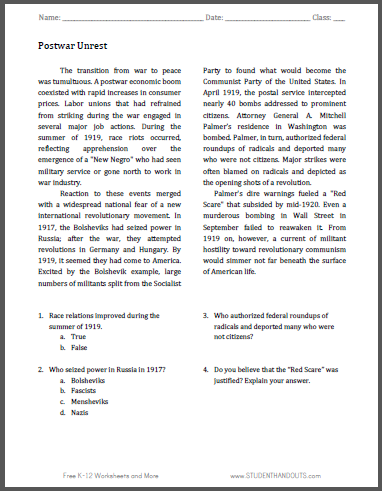 The transition from war to peace was tumultuous. A postwar economic boom coexisted with rapid increases in consumer prices. Labor unions that had refrained from striking during the war engaged in several major job actions. During the summer of 1919, race riots occurred, reflecting apprehension over the emergence of a "New Negro" who had seen military service or gone north to work in war industry.
The transition from war to peace was tumultuous. A postwar economic boom coexisted with rapid increases in consumer prices. Labor unions that had refrained from striking during the war engaged in several major job actions. During the summer of 1919, race riots occurred, reflecting apprehension over the emergence of a "New Negro" who had seen military service or gone north to work in war industry.Reaction to these events merged with a widespread national fear of a new international revolutionary movement. In 1917, the Bolsheviks had seized power in Russia; after the war, they attempted revolutions in Germany and Hungary. By 1919, it seemed they had come to America. Excited by the Bolshevik example, large numbers of militants split from the Socialist Party to found what would become the communist Party of the United States. In April 1919, the postal service intercepted nearly 40 bombs addressed to prominent citizens. Attorney General A. Mitchell Palmer’s residence in Washington was bombed. Palmer, in turn, authorized federal roundups of radicals and deported many who were not citizens. Major strikes were often blamed on radicals and depicted as the opening shots of a revolution. Palmer's dire warnings fueled a "Red Scare" that subsided by mid-1920. Even a murderous bombing in Wall Street in September failed to reawaken it. From 1919 on, however, a current of militant hostility toward revolutionary communism would simmer not far beneath the surface of American life. Questions with answers in bold: 1. Race relations improved during the summer of 1919. a. True b. False 2. Who seized power in Russia in 1917? a. Bolsheviks b. Fascists c. Mensheviks d. Nazis 3. Who authorized federal roundups of radicals and deported many who were not citizens? Attorney General A. Mitchell Palmer 4. Do you believe that the "Red Scare" was justified? Explain your answer. Answers will vary. Click here to print this worksheet. |
 | 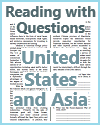 | 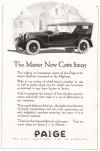 | 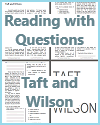 | 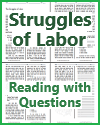 | 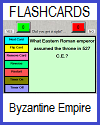 |
| www.studenthandouts.com ↣ American History ↣ American History Readings with Questions |








